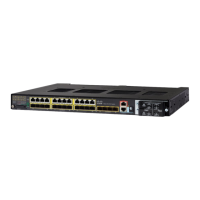275
Configuring VLANs
VLANs
Token Ring TrCRF VLANs
For more information on configuring Token Ring VLANs, see the Catalyst 6500 Series Software Configuration Guide.
Normal-Range VLAN Configuration Guidelines
Follow these guidelines when creating and modifying normal-range VLANs in your network:
The switch supports 1005 VLANs in VTP client, server, and transparent modes.
Normal-range VLANs are identified with a number between 1 and 1001. VLAN numbers 1002 through 1005 are
reserved for Token Ring and FDDI VLANs.
VLAN configuration for VLANs 1 to 1005 are always saved in the VLAN database. If the VTP mode is transparent,
VTP and VLAN configuration are also saved in the switch running configuration file.
With VTP versions 1 and 2, the switch supports VLAN IDs 1006 through 4096 only in VTP transparent mode (VTP
disabled). These are extended-range VLANs and configuration options are limited. Extended-range VLANs created
in VTP transparent mode are not saved in the VLAN database and are not propagated. VTP version 3 supports
extended range VLAN (VLANs 1006 to 4096) database propagation. If extended VLANs are configured, you cannot
convert from VTP version 3 to version 1 or 2. See Creating an Extended-Range VLAN, page 285.
Before you can create a VLAN, the switch must be in VTP server mode or VTP transparent mode. If the switch is a
VTP server, you must define a VTP domain or VTP will not function.
The switch does not support Token Ring or FDDI media. The switch does not forward FDDI, FDDI-Net, TrCRF, or
TrBRF traffic, but it does propagate the VLAN configuration through VTP.
The switch supports 128 spanning-tree instances. If a switch has more active VLANs than supported spanning-tree
instances, spanning tree can be enabled on 128 VLANs and is disabled on the remaining VLANs. If you have already
used all available spanning-tree instances on a switch, adding another VLAN anywhere in the VTP domain creates
a VLAN on that switch that is not running spanning-tree. If you have the default allowed list on the trunk ports of that
switch (which is to allow all VLANs), the new VLAN is carried on all trunk ports. Depending on the topology of the
network, this could create a loop in the new VLAN that would not be broken, particularly if there are several adjacent
switches that all have run out of spanning-tree instances. You can prevent this possibility by setting allowed lists on
the trunk ports of switches that have used up their allocation of spanning-tree instances.
If the number of VLANs on the switch exceeds the number of supported spanning-tree instances, we recommend
that you configure the IEEE 802.1s Multiple STP (MSTP) on your switch to map multiple VLANs to a single
spanning-tree instance. For more information about MSTP, see Configuring MSTP, page 333
Default Ethernet VLAN Configuration
Note: The switch supports Ethernet interfaces exclusively. Because FDDI and Token Ring VLANs are not locally
supported, you only configure FDDI and Token Ring media-specific characteristics for VTP global advertisements to other
switches.

